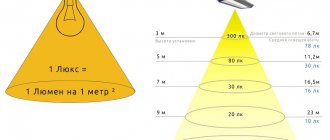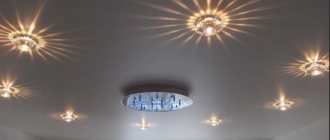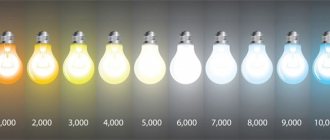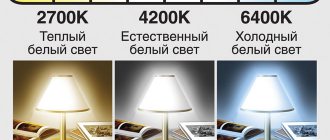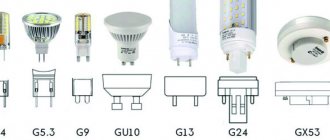In lighting equipment stores you can find a huge selection of light bulbs designed for a wide variety of chandeliers. How can you not get confused in all this diversity and find exactly what you need? This is what we will talk about today.
Let's approach this issue in a comprehensive and organized manner. Many people often underestimate the importance of lighting in a home, but a considerable part of the impression of the interior is formed thanks to the correct illumination of individual objects. In addition, light affects human physiology, biorhythms and mood. Let's analyze several key and secondary criteria to understand what should be considered when choosing light bulbs.
Provided illumination vs energy consumption
Ask yourself exactly how much light you will need in a specific area of the house. If this is a desk or a makeup area, then it is probably much larger than in the hallway. Most people are accustomed to equating the power of the luminous flux to the power of the lamp itself. This used to be true: when only incandescent lamps were used, the energy they consumed was directly related to the amount of light they provided.
However, we propose to approach this from the point of view of physics and the current range of products. Lamp power is measured in watts and shows the amount of energy consumed by the product per unit time. At the same time, the luminous flux itself is calculated in lumens - and therefore the level of light provided to it in our time should be assessed precisely by this indicator and not by any other.
Let's assume that we will use a chandelier with eight sockets and install 8 LED lamps there. The power of each of them is 5 W, which gives us a total of 40 W. That is, in terms of energy consumption it is the same as in one small forty-watt incandescent lamp. But it produces a luminous flux of about 430-440 lm, and only one five-watt LED bulb can provide a luminous flux of 460 lm! Thus, with the same load on the network (40 W), from eight LED lamps we will receive 3680 Lm of total luminous flux, and from a conventional light bulb it is 8.5 times less. The savings, as they say, are obvious.
Of course, the calculation we presented is a demonstration one. In real life, a person does not need such astronomical illumination indicators. Bright light is appropriate only where eye work is required. In all other places it is annoying. It is unwise to buy light bulbs with “a margin” of luminous flux: they will only blind you and cause discomfort.
When professional designers are involved in arranging lamps, they carefully weigh all the features of the room and analyze how it will be used. This approach allows you to zone your home and choose your own light for each zone. Choosing a chandelier based solely on design is as irresponsible as buying a car based solely on the color of its body.
Sometimes, after thinking and weighing all the options, residents come to the conclusion that in a particular room from time to time lighting of rather different intensities is required. And if you don’t want to spoil the interior by installing several new chandeliers at once, a dimmer will come to the rescue. The energy consumption of the light bulb will in fact be almost the same (a difference of 3-5%), however, the consumer will have the opportunity to independently adjust the brightness level, dimming the light or increasing the brightness as needed.
Types of LED lamps
LED bulbs are usually divided into several categories. The division is carried out, for example, by lighting intensity in comparison with incandescent lamps:
- For a 25-watt incandescent lamp, the equivalent among LED lamps is a 5.5-watt bulb.
- An 8 W diode source is identical to a 40 W incandescent lamp.
- For an 11 W LED, the analogue is 60 W.
- A 15 W diode-based lamp is equal to a 70-90 W incandescent lamp.
The main characterizing property of an LED device is the type of base.
There are the following types of socles:
- G-9 is a pin type base.
- E27 is the most common type of base.
- G4 - socket for small light bulbs. Most often used for lighting.
- E14 - similar to E27, but smaller in diameter. Used in chandeliers in the form of a candle lamp or minion.
- GU10 - used in spotlights.
- GU5.3 is the base most often used in chandeliers.
Colorful temperature
We are sure that you are familiar with this concept. Manufacturers of almost all modern lamps have been indicating the temperature of the provided glow for several years now. First of all, it is very convenient from a purely aesthetic point of view. Those who want to charge themselves for work buy bulbs with cold light, and those who, on the contrary, want to relax, buy bulbs with extremely warm light. Often four words are used to denote temperature: “warm”, “cold”, as well as “neutral” and “daytime”, which are considered extremely close concepts. The scale is presented in Kelvin, where a higher value corresponds to the distance from the warm glow. In stores, most often the general range is formed by products with values from 2700 K to 6000 K.
You should select a light bulb according to the following principles.
- For a chandelier installed in a residential area, a lamp with a color temperature in the range of up to 3000 K is perfect. If the lamp is located high enough, you will get an even, eye-pleasing light shade that falls into the “warm” category.
- In the work area, you can place neutral light, with a color temperature located between warm and cooler tones (3000–4000 K). It will give an unobtrusive tint and will not tire your eyes when reading or working at the computer for a long time.
- For a chandelier in a spacious kitchen, a light bulb with a “colder” temperature (4500–5000 K) is more suitable: the eternal heat that accompanies the hob requires compensation, therefore the “coolness” introduced by the light will be highly appreciated by your body on a subconscious level.
- If you want to illuminate a really large room, then you should proceed from its purpose. Really cold light (over 6000 K), which belongs to the daylight white group, would be appropriate in a warehouse or office, since constant neutral lighting is required there, allowing objects to be clearly distinguished. At the same time, for a large hall or studio apartment with an open layout and high ceilings, compromises should be sought. Depending on the type of chandelier, you can either flood the space with warm light or fill it with bright daylight.
The most significant and concise recommendation is this: do not mix! If the room is viewed through from a certain angle, different color and temperature shades look ridiculous in it. A lamp medley is only appropriate in a club, and even then - not always. The difference in temperature does not allow the eye to adjust, and you will feel uncomfortable all the time.
Of course, it is permissible to zone a room, but this must be done smoothly, selecting lamps that are similar in color temperature. After all, if this room is multifunctional, it would not be amiss to provide for the autonomous inclusion of different light bulbs in the chandelier for different purposes. Thus, you can relax and watch TV under one lighting, and have a party and gather guests at the festive table under another. A large chandelier in the living room with duplicate sockets copes wonderfully with this task.
Types of socles
What is a base anyway? This is the part of the light bulb that provides mounting in the lamp socket and serves to conduct electricity. Typically, bases are made of metal or ceramic.
All bases are divided into two large groups: pin and threaded. Each type of base is designated by a letter and a number, where the letter is the group it belongs to and the number is the distance between the contacts or the diameter. For example, E27 is a threaded base with a diameter of 27mm.
Let's look at the most popular bases for home use.
Color rendering index
People often undeservedly omit this nuance. Some simply out of ignorance, others because of its complexity, for others it seems simply unimportant. In any case, we could not ignore this point, since most of us in real life still do not ignore the colors of surrounding objects.
The color rendering index tells how the color of familiar interior elements will be perceived when the room is illuminated by a light bulb with a specific shade and glow temperature. Obviously, this indicator is truly complex. And he is responsible not only for the design and aesthetic component of the home, but also for how adequately we perceive ourselves in the mirror. First of all, this, of course, concerns women who can first choose an outfit for a long time, studying themselves in the reflection, and then, going out into the street, discover that in the rays of the sun it looks completely different from what was planned. A similar story can happen with makeup if the color rendering index in the thematic zone was chosen incorrectly.
When reading the packaging of light bulbs, you should orient yourself this way. The absolute measure for us will be the light of the sun - it is this that is taken as 100% on the scale of correct color rendering. For the highest quality modern light bulbs, the upper limit is 95%, but in reality, people rarely need such high levels. For household needs, lamps with a CRI index (from the English “color rendering index”) of over 80% are suitable. In addition, there may be a marking “80 Ra” - this is the same value, but on a different scale.
To avoid getting into trouble in this matter, do not buy nameless Chinese light bulbs. The values declared by the manufacturer may turn out to be extremely far from reality or simply indicated based on the values of the scale developed by the manufacturer itself. Thus, the consumer actually remains deceived in his expectations, but the plant is legally clear, because creating your own working measurement system at enterprises is not prohibited. If there is a complete absence of color rendering index on the packaging, it is best to refuse such a purchase entirely.
Safety regulations
The power of the lamp must be correlated with the capabilities of the lamp.
This threshold is usually written on the sockets; it cannot be exceeded, otherwise the lamp may “leak” and the lampshade may melt or even catch fire due to a short circuit. There is also an indicator of the moisture protection of the lamp: the usual degree of protection is indicated by the abbreviation IP 20, for baths you need lamps marked from IP 44 to IP 55, the highest is IP 68.
When installing, it is critical to calculate how much weight the chandelier will support the ceiling mount.
Lamps also have an indicator of the amount of current they conduct - these are volts (V/V). A level of 12 or 24 volts is safe for humans, but 220 volts is already fraught with consequences, especially in the bathroom.
It is important to consider that gas-discharge and fluorescent lamps are not recommended in residential interiors, and halogen lamps get very hot.
Scattering angle
Due to the design features of the lamp, different models may diffuse light differently. In order to form the required direction, various auxiliary optics are often used (matte polycarbonate bulbs, focusing/scattering lenses, etc.).
The angle of illumination of objects really plays a significant role in the feeling of comfort in a room. The higher it is, the larger the area your lamp will be able to illuminate. This indicator is standardized at the official level for various types of activities. For example, a workplace should be illuminated no less than 27°, and a large room should be illuminated no less than 120-130°.
But not all types of lamps are able to provide the required values. The same halogens are limited to 32-38°, which will automatically require the installation of a large number of lamps within one room for overhead lighting. At the same time, the range of operation of LED lamps is much wider. Their range is divided into several parts. Some models are great for directional light and are installed in the makeup area, near the workplace or computer. Others are suitable for illuminating spacious rooms. Among them there are lamps with a lighting angle of over 270°, which allows the most daring ideas of designers to be realized when designing an interior.
In LED lamps, manufacturers can specifically position the diodes so that they emit light in different directions. The leading role in this regard is played by the technology of the light bulb: SMD or filament. For the first type, the determining criterion will be the direction of the LED. It emits a luminous flux solely depending on it, and is not able to cover large spaces. At the same time, according to filament technology, the emitting element is a sandwich consisting of a substrate, LEDs and a phosphor fill. Since the light emitted by the source will in any case reach the phosphor, the limitations associated with the scattering angle are not important for this type of light bulb.
As a technical indicator, the scattering angle value indicates the range in which at least 50% of the maximum amount of light emitted by the lamp is present. Some companies provide a simplified diagram with a visual representation of the direction of the light flux directly on the packaging of their products. The classification of such diagrams is presented in GOSTs: the traditional one is divided into 7 types, but with in-depth study it is much more extensive.
When properly designing indoor lighting, it is the dispersion angle that serves as the key zoning factor:
- to illuminate individual objects or small spaces, light sources with an angle of 30° or 60° are used;
- for overhead light of uniform saturation in large rooms - lamps with a wide angle - 140°, 160° or 180°;
- To solve individual lighting problems, lighting devices with different suspension heights can be used.
It should be noted that the selection of a light bulb for it will also depend on the design of the lamp itself. If you have a lampshade of complex shape, with overlap areas or made of dense material, part of the light flux will inevitably be lost. In addition, the very direction of the lampshade orients the luminous flux, and its elongated shape can slightly narrow the illuminated range. In each specific case, it is necessary to analyze such nuances and select a light bulb taking into account as much information as possible about the lamp, as well as the illumination required for a given zone.
Design solutions
With the advent of light diodes, there are almost endless possibilities in lighting options. Compactness (down to drop-shaped bulbs), high ergonomics, lack of heat transfer, high-quality light, ease of installation, variety of colors - all these properties allow us to consider LEDs as a universal means for realizing design ideas.
Using LEDs, they create luminous floors, create mosaic paintings, highlight individual areas of decorative trim, create local lighting in a room or twinkling stars for the “sky” on the ceiling.
Lamps with horns occupy a special place in design solutions. Thanks to this design, it becomes possible to change the direction of the light. Orienting the horn upward will illuminate the ceiling, while pointing downward will provide diffused light.
Auxiliary criteria
Ceiling lamp
If you are used to using an intricate lampshade or a carved lampshade, think about what percentage of light distortion they will introduce: both in the color of the glow and in the illumination. One way or another, in this context the lampshade acts as an optical filter. The overall appearance of the room depends on whether it is matte, transparent or colored. Depending on whether the lampshade is single or multi-colored - there is a rainbow on the walls. Finally, the material itself from which it is made sets the overall tone of the interior.
Let's imagine that a light bulb with warm light, level 2700 K in color temperature, is installed in a traditional dark beige or yellow lampshade. In this case, the room will be flooded with a “concentrated” warm glow, causing suffocation rather than pleasant warmth. You especially shouldn’t take such risks in the country house or in the kitchen. Unpleasant sensations are guaranteed for you.
A classic crystal chandelier or simply a transparent lamp harmonizes best with transparent light bulbs. The whole point of such lighting devices is precisely in the play of light, and if you put a matte lamp there, the entire desired effect will be lost.
At the same time, a coated light bulb will fit under the matte lampshade. It will immediately scatter the light and will never blind a person in those places where the lampshade itself should be visible through.
Let's not devote too much time to lamps for other places in the apartment. We believe that the basic principle is clear - the light bulb and the lamp must be combined with each other and not cause either aesthetic or physical discomfort to a person.
Base
It’s a little funny to dwell on this criterion, but often buyers take light bulbs from the shelves after reading all the main characteristics and completely forgetting about the type of base. It is all the more interesting that such consumers know exactly the desired color temperature, the required luminous flux, checked the color rendering index in advance, and also inquired about other products from the same manufacturer as the selected product. And only when checking the light bulb at the checkout it turns out that you should have taken the exact same lamp from a nearby rack, but with a different base.
Therefore, let us remind you: the most common base in our country is E27. The overwhelming majority of light bulbs use it. This standard threaded connection is one of the simplest and most reliable at the same time.
In second place is the so-called “minion”, or E14. The socket for it is often installed in sconces and small lamps. However, sometimes the latter type can be found in ordinary ceiling chandeliers. Here it is used to add additional lightness and elegance to the structure.
Sometimes you come across lamps with very small base diameters (E5, E10, E12) or, conversely, larger ones (E40), which are not used in everyday life and are used exclusively for street lighting. However, their scope of application is extremely limited and the consumer is unlikely to be deceived when choosing a light bulb for them.
From time to time, in European-made chandeliers you can also see sockets for a pin base. It is absolutely impossible to forget that you have a pin rather than a threaded connection, but it is quite possible to be deceived by their diversity, even though the choice of lamps for such sockets is significantly smaller (the main ones are , , GU5.3). Sometimes, if you really like a chandelier, it makes sense to even replace the original socket with a more common one and never have to worry about searching for specific light bulbs in the future.
Price
No one has canceled the price factor, but every prudent owner understands: a quality item cannot be too cheap. It’s better to buy a good light bulb once, and then forget about the need to replace it for five to seven years.
We are mainly talking, of course, about modern LED lamps from well-known global manufacturers. If we talk about the long-term perspective of using different types of light bulbs, this type will show the greatest savings, and the usual and beloved incandescent light bulbs will show the greatest wastefulness in relation to your family budget.
Service life and replacement
Compared to incandescent or even halogen bulbs, LEDs last much longer. For example, the warranty on products usually ranges from 3 to 5 years. However, the actual life of a light bulb can reach 15 years or more. In connection with this, their price becomes completely justified.
LED lights are easy to install. However, there are situations when the light bulb does not light up or continues to emit light after being turned off. In such cases, you will need to check the connection quality. To do this, pull out the light bulb and screw it back into place. If such actions do not produce results, it is recommended to seek advice from the seller or electrician.
Advice! If the lamp continues to light when turned off, the problem most likely lies in the insulating layer of the wiring or in the switch.
Some LED bulbs flicker noticeably. This mode of operation is extremely irritating not only to the human nervous system, but also to his vision. Flicker is one of the most common problems with LED light sources. Moreover, it is difficult to detect such a flaw when purchasing a lamp, since it is caused by the design features of the electrical network of a particular house, as well as the general output voltage.
Another potential problem is lack of load. In this case, remote control of LED bulbs becomes impossible. Most often in such cases, manufacturers advise replacing the power supply.
Characteristics of lamps
Lighting characteristics of various types of lamps
LED chandelier lamps have a number of characteristics that the user must take into account when purchasing.
- Power. In everyday life, products rated at 3-20 W are used, but you can also find powerful lighting devices up to 50 W.
- Voltage. There is a network 220 and a working one for 12 W LEDs. 12 W devices are connected via a power supply. 220 V devices have a driver.
- Colorful temperature. Shows the type of radiation - cold, warm, neutral. At home, lamps of 2700-3000 K are used.
- Light flow. Depends on the brightness of the light.
- Lighting angle.
- Operating temperatures.
Additional characteristics include the radiator configuration and the presence of a dimmer.
The most reliable and well-known LED manufacturers are Philips, Gauss, Osram, Navigator.
